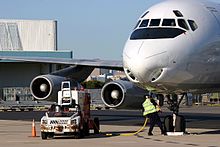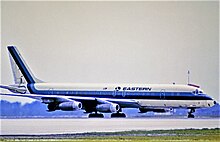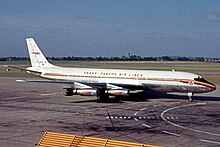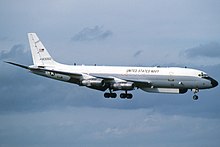Douglas DC-8
| Douglas DC-8 | |
|---|---|
 Douglas DC-8-72 from NASA |
|
| Type: | Four-engine airliner |
| Design country: | |
| Manufacturer: | |
| First flight: |
May 30, 1958 |
| Commissioning: |
September 18, 1959 |
| Production time: |
1958 to 1972 |
| Number of pieces: |
556 |
The Douglas DC-8 is a four-engine jet passenger aircraft produced by the Douglas Aircraft Company . It is a low wing aircraft with a conventional tail unit . Between 1959 and 1972 a total of 556 machines were delivered. On August 21, 1961, a DC-8-43 broke the sound barrier ( Mach 1.0124) during a test flight in descent , making it the first passenger aircraft to reach supersonic speed .
development
Development of the DC-8 began in 1952 with preliminary studies for an aircraft that, in addition to carrying passengers, was also intended to cover the emerging demand from the US Air Force for a tanker for refueling its jet-powered strategic bomber fleet. In the summer of 1953, the basic key data for the machine were defined. The airlines showed due to the Comet accidents and their young, unamortized fleets of piston engine - propeller aircraft not very interested in a jet airliner. The competitor Boeing already had a prototype in production with the Boeing 367-80 , which had its rollout on May 14, 1954 . The US Air Force decided on this type of aircraft, from which the Boeing KC-135 emerged .
After losing the military contract, Douglas concentrated on developing a passenger aircraft. The design provided for a 45.90 m long machine with a wingspan of 43 m. The fuselage diameter has been increased slightly to accommodate six seats per row. This in turn required changes to the wings and tail unit. Depending on the engines and the fuel capacity, the takeoff weight should be between 120 and 139 tons . This made the aircraft significantly heavier than its competitor Boeing 707-100 , but had a greater range. In combination with the engines currently being developed, the machine, unlike the Boeing 707-100 and De Havilland Comet 4 , would be able to complete transatlantic flights without stopping over in Newfoundland.
The DC-8 was officially announced on June 7, 1955. The British BOAC had ordered the Comet 4 in March 1955 , as a result of which Pan American World Airways ( Pan Am ) urgently needed a jet aircraft for their transatlantic routes and entered into sales negotiations with Douglas in July 1955 . The problem for Pan Am was that the DC-8 would be available around a year later than the Boeing 707-100. Pan Am split their order on October 13, 1955 and ordered 20 Boeing 707s and 25 Douglas DC-8s. Twelve days later United Air Lines ordered 22 machines in the lighter continental version. The decisive factor for United was the larger fuselage diameter of the DC-8, whereupon Boeing changed the 707 design and widened its fuselage accordingly. Further orders were received from the scheduled airlines National Airlines , KLM , Eastern Air Lines , Japan Air Lines , SAS , Delta Air Lines , Swissair , Alitalia , Transports Aériens Intercontinentaux , Trans-Canada Air Lines and Union Aéromaritime de Transport . In 1960, Trans International Airlines was the first charter airline to order two planes.
A new assembly plant was built in Long Beach ( California ) for the production of the Douglas DC-8 . The model series 10, 20, 30 and 40 were initially offered. The prototype, in the form of a DC-8-11, left production in April 1958 and took off on its maiden flight in Long Beach in front of 60,000 spectators and employees on May 30, 1958 . In order to get FAA approval quickly , ten machines were used for test flights. There were some changes during the test flights. The air brakes provided proved to be inadequate and were omitted with the introduction of the thrust reverser . This makes the DC-8 one of the few aircraft on which the reverse thrust can also be activated in flight. In order to improve the slow flight characteristics, slats were installed. However, the machines did not reach the calculated speeds when cruising. Therefore, the wing tips had to be changed again to reduce drag . FAA approval was granted on August 31, 1959. On September 18, 1959, the first series 20 machines went into regular service at United Air Lines and Delta Air Lines .
construction
The fuselage of the DC-8 is made of all-metal construction, pressurized and designed as a double circular cross-section. The cantilevered wings have two spars . There are spoilers on the top of the wing . Double slotted flaps are installed to increase lift .
The wings are de-iced with hot bleed air . The tail unit is also made of all-metal construction and is self-supporting. The landing gear is retractable and consists of a steerable nose wheel with twin tires and the main landing gear with two landing gear legs and four wheels each. The main landing gear is braked with the help of disc brakes. A thrust reverser is also available for braking after landing and for reducing speed during emergency descents .
With the machines converted to the Super 70 series, the use of thrust reverser is not allowed because of the powerful new engines in the air.
The air for the air conditioning is sucked in through two inlets on the left and right of the aircraft nose. Compressed by bleed air-driven compressors, the heated air is fed into the cabin after mixing with cold air at cabin temperature. This makes it one of the few commercial aircraft (next to the Boeing 787 , for example ) in which no bleed air from the engines is introduced into the air conditioning system and thus into the cabin, thus preventing the cabin air from being contaminated and an aerotoxic syndrome among passengers and crew. Only the Super 70 series mainly used bleed air from the CFM56 engines.
Originally turbojet engines of the type JT3C were used with the DC-8, later versions received the turbofan engine JT3D or the General Electric / SNECMA CFM56. The machine could also be equipped with the JT8.
Versions
The models of the early series had uniform fuselage dimensions and only differed in the choice of engines used, in the maximum take-off weights ( MTOW ) and in technical details.
Early series
- The DC-8 Series 10 was delivered with the Pratt & Whitney JT3 C-6 engines delivering 60.50 kN of thrust . These machines were designed primarily for domestic American flights. The first series DC-8-11 still had the wing tips with too high air resistance. These machines were gradually converted to DC-8-12 , which, in addition to the changed wing tips, also had slats and a take-off weight increased to 123 tons. A total of 28 series 10 machines were produced, some of which received new engines after delivery and then met the standard of series 50.
- The DC-8 Series 20 was delivered with the 70.80 kN Pratt & Whitney JT4 A-3 engines. The takeoff weight increased to 125 tons. 34 machines were produced. The first flight of this series took place on November 29, 1958.

- The DC-8 Series 30 was delivered with the 72.50 kN Pratt & Whitney JT4A-9 engines. In addition, however, the fuel capacity was increased by a good 33 percent in order to be able to serve transcontinental routes. The first flight took place on February 21, 1959. For this purpose, the fuselage and the landing gear had to be reinforced. The first machines in this series, the DC-8-31 , received their approval on February 1, 1960 with a takeoff weight of 136 tons. The DC-8-32 was similar, but allowed a takeoff weight of 140 tons. The type DC-8-33 had JT4A-11 engines delivering 78.40 kN, a change in the flaps that enabled lower fuel consumption when cruising. The flaps could be moved to a cruising position of 1.5 °. The undercarriage was reinforced again so that a take-off weight of 143 tons was possible. Many of the -31 and -32 machines were later converted to -33.
- The DC-8 Series 40 was the first passenger airliner to be equipped with turbofan engines, which were considerably quieter and more economical than previous turbojets . The smoke development was also significantly lower. Used came Rolls-Royce - Conway -Triebwerke with 78.40 kN thrust. The first flight took place on July 23, 1959, the certification on March 24, 1960. The DC-8-41 had a takeoff weight of 136 tons, the DC-8-42 one of 140 tons. The DC-8-43 had the same key change as the DC-8-33. In addition, the wings were changed, which meant a little more fuel capacity and, above all, a reduction in drag, increased range by eight percent and increased cruising speed by 10 knots . The takeoff weight was 143 tons. These changes were also incorporated into all other DC-8 types. 32 machines of the 40 series were built.
- The DC-8 Series 50 also had turbofan engines, Pratt & Whitney JT3D -1 with 76.10 kN thrust or JT3D-3B with 80.60 kN thrust were used. The series DC-8-51 , DC-8-52 and DC-8-53 differed in their take-off weights of 126, 138 and 142 tons respectively. Late versions of the DC-8-53 featured the stronger cells and landing gear of the cargo versions and had a takeoff weight of 147 tons. The first flight took place on December 20, 1960. 88 machines were built from this series.
- DC-8 series Jet Traders were freighter versions of the DC-8-50. They had a front cargo hold with a large cargo door and a reinforced cabin floor as well as a cabin behind it for initially 54 passengers. This arrangement was replaced a short time later by a sliding device for separating the hold, which made it possible to carry between 25 and 114 passengers. The first flight took place on October 29, 1962, the certification on January 29, 1963. The first machine was delivered to Trans International Airlines on April 26, 1963 . There was also a variant without a cabin window, of which only 15 machines were sold to United Airlines. The DC-8F-54 had a takeoff weight of 143 tons, while the DC-8F-55 had a takeoff weight of 147 tons. Both types were powered by JT3D-3B engines with 80.60 kN of thrust. A DC-8-54F was converted by the US Navy to emulate enemy communication and radar systems as an EC-24 for training purposes .
On August 21, 1961, a DC-8-43 broke the sound barrier during an incline flight from 52,090 ft (15,877 m ) to 41,088 ft (12,524 m). The speed of Mach 1.012 could be maintained for 16 seconds. With the crew of Captain William Magruder, First Officer Paul Patten, Flight Engineer Joseph Tomich and Flight Test Engineer Richard Edwards, the DC-8 took off from Edwards Air Force Base in California on a test flight. Data were to be collected on a newly designed wing leading edge . A North American F-100 and a Lockheed F-104 , flown by Chuck Yeager , accompanied the DC-8 during the climb. This DC-8 was the first civil and the first jet passenger aircraft to reach the speed of sound. The aircraft was later delivered to Canadian Pacific Air Lines .
After the excellent start of the series, sales were soon sluggish. The reason was the entrepreneurial decision of the manufacturer Douglas not to offer a shortened or lengthened cabin, despite the large number of variants, because the development department was fully occupied with the development of the Douglas DC-9 . In 1964 only 14 machines were sold, the majority of which were sold as cargo machines. Boeing with the 707 showed itself to be more adaptable in terms of cabin length and gained ever larger market shares .
Super sixties

After completing the development of the DC-9 and its maiden flight on February 25, 1965, Douglas finally responded in April 1965 and announced the cabin extension for the DC-8 with three new models. Until the Boeing 747 appeared in 1970, the so-called Super Sixties were the largest passenger aircraft of their time with over 250 passenger seats . A total of three basic versions were offered:
- The DC-8 Series 61 was based on the -53 with the same take-off weight. The range was correspondingly lower compared to the -53. To increase the capacity, the front cabin was lengthened by 6 m and the rear by 5 m, resulting in a total length of 57 m. The cabin had to be reinforced accordingly because of the greater loads. The landing gear, on the other hand, did not need to be extended. These machines typically held 210 passengers - with compact seating, 269 passengers could also be carried. The first flight took place on March 14, 1966, the certification on September 2, 1966. In addition to the passenger version, Douglas also offered "Convertible Freighter" (CF) ex works, which had cabin windows, an additionally reinforced cabin floor and a cargo hatch, making them optionally available Passenger or cargo aircraft were usable. A total of 88 machines were built, ten of them in the CF version.
- The DC-8 Series 62 corresponded to the -53 and was designed for long haul. Compared to the -53, the cab has been lengthened by only 1.02 m at the front and rear. To increase the range, the wing tips were lengthened by one meter in order to increase the fuel capacity and further reduce air resistance. At the same time, the engine mountings and cowlings were changed. Compared to the -61, the machine received a slightly larger take-off weight of 151.953 tons and thus had a range of 9,630 km when fully loaded. The first flight took place on August 29, 1966, the approval in April 1967. The last machines built had a take-off weight increased to 158.760 tons and were given the designation DC-8-62H . In addition to the basic version as a passenger aircraft, the windowless all-freight version ("All Freight" or AF) and the variant as a "Convertible Freighter" (CF) were offered at the factory. Douglas manufactured a total of 67 series 62 machines , ten of them as DC-8-62CF and six as DC-8-62AF.
- The DC-8 Series 63 was a mixture of the long cab of the -61 with the improvements of the -62. JT3D-7 engines with a thrust of 85 kN were used as propulsion. The maximum take-off weight was 159 tons, the range with maximum payload 7,600 km. The first flight took place on April 10, 1967, the approval on June 30, 1967. The 63 series was also offered at the factory as cargo-only aircraft (AF) and as combi aircraft (CF). A special version was the DC-8-63PF, which was only ordered by Eastern Air Lines and had the reinforced cabin floor of the cargo version, but no loading hatch on the main deck. Eastern chose this version in order to be able to transport soldiers with field packs on military mission flights. A total of 107 machines of the 63 series were manufactured, 53 of them as DC-8-63CF, seven as DC-8-63AF and six as DC-8-63PF.
The last DC-8-63 machine left the assembly hall on May 13, 1972. Immediately afterwards, the production facilities were used to manufacture the McDonnell Douglas DC-10 .
Super seventies

At the beginning of the 1970s, discussions began about the increase in air traffic, in particular about the growing noise pollution of airport residents. The DC-8 types of the 61 to 63 series were the loudest of all jet aircraft. Over time, the noise emissions became a problem for the airlines: With the noisy DC-8 planes, they were no longer allowed to fly to some airports .
Therefore, in the early 1970s, some airlines asked McDonnell Douglas whether quieter engines could be installed on the DC-8 machines. Initially, companies with solutions to reduce noise emissions, so-called hush kits , pushed onto the market, but did not meet all expectations. Finally, with the CFM56 engine , CFM International brought a variant into play that neither McDonnell Douglas nor Boeing could ignore. Development began in the late 1970s and led to the Super Seventies . None of the Super Seventies machines were newly produced, rather they are conversions of their predecessors. During the Super Seventies, it is not allowed to use the reverse thrust before landing.
The DC-8-71 emerged from the DC-8-61, but underwent major modifications, as the wings and the engine mountings also had to be changed. Due to the higher weight of the new engines, the payload decreased slightly, although the maximum take-off weight remained unchanged. The first flight of such a converted machine took place on August 15, 1981. Approval was granted in 1982. A total of 110 machines of the DC-8-60 series had been modified accordingly by the end of 1986.
The DC-8-72 and DC-8-73 were converted to the new engines without any further external changes to the DC-8-62 and DC-8-63. These were CFM56-2C5 turbofan engines with a high bypass ratio delivering 98.50 kN of thrust. Alternatively, a Pratt & Whitney PW JT8D-209 could be used. The engine cowling was redesigned by Grumman . Cammacorp in Los Angeles was in charge of the renovation . In addition to the modified engines, an auxiliary power unit (APU) for an autonomous power supply and an environmental management system were also available.
As a result of the conversion, the noise emissions were reduced by 70 percent and the fuel consumption of the engines was reduced by 20 percent , so that the range of the machine was increased considerably.
use
A total of 48 airlines in 28 nations received brand new machines. Proof of the robustness of the type is that some of the machines completed more than 100,000 flight hours. From the 1970s, it was increasingly used as a cargo aircraft, with numerous passenger aircraft being retrofitted with a cargo hatch.
In addition to civilian use, the DC-8 was also used by the armed forces of France , Gabon , Spain and Togo - mainly as a "VIP" or transport aircraft. The US Navy uses a machine as an enemy representation aircraft . The NASA sets since 1985, a DC-8-72 as a flying laboratory (DC-8 Airborne Laboratory) for the review of space sensors , atmospheric research and other scientific missions one, such as the exploration of the Arctic ice.
Current operator
In June 2004 150 units of the DC-8 were still in service, mainly as cargo planes. As of July 2018, there are only eight active aircraft left in the world.
| series | Construction year | country | society | number | Remarks |
|---|---|---|---|---|---|
| DC-8-55F | 1965 |
|
Forces Armées de la République Democratique du Congo | 1 | Cargo machine |
| DC-8-62H | 1967/69 |
|
Trans Air Cargo Service | 2 | Cargo machines |
| DC-8-73CF | 1970 |
|
Trans Air Cargo Service | 1 | Cargo machine |
| DC-8-62H | 1969 |
|
Republic of Togo | 1 | Government aircraft, VIP equipment |
| DC-8-73CF | 1968 |
|
CFS Air Cargo operated by Air Inter1 | 1 | Cargo machine |
| DC-8-72CF | 1969 |
|
Samaritan's Purse | 1 | Aid organization's cargo plane |
| DC-8-72 | 1969 |
|
NASA | 1 |
|
Only parked are a DC-8-73AF (5Y-RCA, built in 1969) from Ribway Cargo Airlines ( Kenya ) and a DC-8-70 (OB-2059-P, built in 1968) from Skybus Jet Cargo (USA), last leased to Peruvian Airlines .
Operators in Germany, Austria and Switzerland
In Germany DC-8s were used by Lufthansa (in full livery, rented by Trans International Airlines ), Südflug , Atlantis , German Cargo , Condor Flugdienst (operated by German Cargo) and Lufthansa Cargo .
In Austria, Austrian Airlines used a Douglas DC-8-63CF leased from Overseas National Airways from September 1973 to December 1974 in its own livery on cargo flights.
In Switzerland, DC-8s were used by Air Starline , Balair , SATA and Swissair .
Military operator
In the past, France , Spain , Peru , the Philippines , Thailand and the USA used the DC-8 for military purposes.
Incidents
In accidents with the DC-8, between the first flight in 1958 and February 2019, there were 83 total losses in 556 aircraft. In 53 of them, 2332 people were killed.
Technical specifications
| Parameter | Data of the last series variant DC-8-63 |
|---|---|
| crew | 3 cockpit, 5 cabin |
| Passengers | 259 |
| length | 57.04 m |
| span | 45.24 m |
| height | 13.00 m |
| Cabin length | 42.29 m |
| Cabin width | 3.50 m |
| Cabin height | 2.21 m |
| Wing area | 271.93 m² |
| Wing swept | 30.6 ° |
| Empty mass | 89,017 kg |
| Max. Takeoff mass | 158,757 kg |
| payload | 30,125 kg |
| Top speed | 965 km / h |
| Rate of climb | 11 m / s (near the ground) |
| Max. Range | 12,390 km |
See also
literature
- Bernd Vetter: Douglas DC-8: Pioneers of the jet age . GeraMond, Munich 2001, ISBN 3-932785-86-X .
- Terry Waddington: Douglas DC-8 . In: World Transport . tape 2. , Great Airliners Series Vol 2. Miami Fl 1996, ISBN 0-9626730-5-6 .
- Stewart Wilson: Boeing 707, Douglas DC-8 & Vickers VC10: Legends of the Air . In: Airlife . tape 6 . Australian Aviation, Shrewsbury 1999, ISBN 1-875671-36-6 .
- Ugo Vincenzi: Early American Jetliners - Boeing 707, Douglas DC-8 & Convair 880 . Motorbooks International, Osceola WI 1999, ISBN 0-7603-0788-1 .
- George W. Cearley: Douglas DC-8 - A Pictorial History . Self-published, Dallas TX 1992.
Web links
Individual evidence
- ↑ a b c d Aero, issue 101, year 1985
- ↑ a b Aero 5/2008, p. 88
- ^ Flight International, November 18, 1960
- ↑ Bernd Vetter: Douglas DC-8: Pioneers of the Jet Age. GeraMond, Munich 2001, ISBN 3-932785-86-X , p. 86.
- ↑ Bernd Vetter: Douglas DC-8: Pioneers of the Jet Age. GeraMond, Munich 2001, ISBN 3-932785-86-X , p. 24.
- ↑ Bernd Vetter: Douglas DC-8: Pioneers of the Jet Age. GeraMond, Munich 2001, ISBN 3-932785-86-X , pp. 86-87.
- ↑ Douglas Passenger Jet Breaks Sound Barrier.Retrieved February 20, 2015.
- ↑ I Was There: When the DC-8 Went Supersonic ( Memento of the original from May 8, 2014 in the Internet Archive ) Info: The archive link was inserted automatically and has not yet been checked. Please check the original and archive link according to the instructions and then remove this notice. Air & Space / Smithsonian magazine. Retrieved February 20, 2015.
- ↑ Bernd Vetter: Pioneers of the Jet Age, DC-8. Gera Mond Verlag, Munich 2001, ISBN 3-932785-86-X , p. 86.
- ^ DC-8 Airborne Laboratory , nasa.gov, accessed August 14, 2011
- ↑ DC-8 Airborne Laboratory Photo Collection @ dfrc.nasa.gov
- ↑ IceBridge - Antarctic 2011 , nasa.gov
- ↑ Planespotters.net, Douglas DC-8 Operators (English) accessed on July 23, 2018
- ↑ Rzjets, Douglas DC-8-63CF, OE-IBO (in English), accessed on February 1 2019
- ^ Ulrich Klee, Frank Bucher et al .: jp airline-fleets international . Zurich Airport 1967–2007.
- ^ Douglas DC-8 Statistics , Aviation Safety Network , accessed February 25, 2019.









